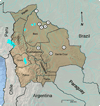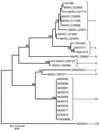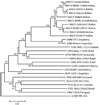Genetic diversity among Bolivian arenaviruses
- PMID: 19041349
- PMCID: PMC2795640
- DOI: 10.1016/j.virusres.2008.10.016
Genetic diversity among Bolivian arenaviruses
Abstract
Machupo virus and Chapare virus are members of the Tacaribe serocomplex (virus family Arenaviridae) and etiological agents of hemorrhagic fever in humans in Bolivia. The nucleotide sequences of the complete Z genes, a large fragment of the RNA-dependent RNA polymerase genes, the complete glycoprotein precursor genes, and the complete nucleocapsid protein genes of 8 strains of Machupo virus were determined to increase our knowledge of the genetic diversity among the Bolivian arenaviruses. The results of analyses of the predicted amino acid sequences of the glycoproteins of the Machupo virus strains and Chapare virus strain 200001071 indicated that immune plasma from hemorrhagic fever cases caused by Machupo virus may prove beneficial in the treatment of Bolivian hemorrhagic fever but not hemorrhagic fever caused by Chapare virus.
Figures




References
-
- Barry M, Russi M, Armstrong L, Geller D, Tesh R, Dembry L, Gonzalez JP, Khan AS, Peters CJ. Brief report: treatment of alaboratory-acquired Sabiá virus infection. N. Engl. J. Med. 1995;333:317–318. - PubMed
-
- Buchmeier MJ. Arenaviruses: protein structure and function. Curr. Top. Microbiol. Immunol. 2002;262:159–173. - PubMed
-
- Buchmeier MJ, Lewicki HA, Tomori O, Oldstone MBA. Monoclonal antibodies to lymphocytic choriomeningitis and Pichinde viruses: generation, characterization, and cross-reactivity with other arenaviruses. Virology. 1981;113:73–85. - PubMed
-
- Cajimat MNB, Fulhorst CF. Phylogenyof the Venezuelan arenaviruses. Virus Res. 2004;102:199–206. - PubMed
Publication types
MeSH terms
Substances
Grants and funding
LinkOut - more resources
Full Text Sources

